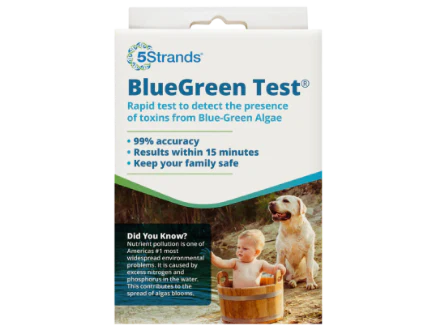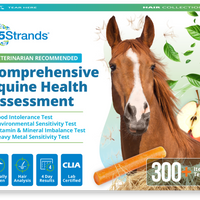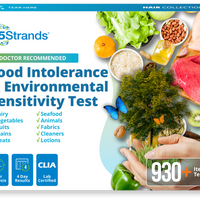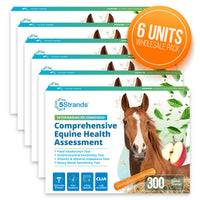It's no secret that gluten-rich flour is a mainstay for the fast-food industry. Fast-food restaurants have become an iconic part of American culture, a staple in many diets. Not all of us are built the same when it comes to food. For some, wheat flour used in classic American dishes is no problem; however, others may have difficulty digesting gluten-containing items and can experience unpleasant symptoms. Knowing what foods your body best responds to is key for maintaining optimum health.
From celiac disease to non-celiac gluten sensitivity, people are finding that they have a gluten intolerance. If you suspect you might be affected by gluten intolerance, taking a test is always the best starting point for understanding your situation.
But what exactly is gluten, and why can't people with an intolerance consume it? Knowing the history, symptoms, and testing process can help inform decisions related to your long-term healthcare. In this blog post, we’ll look into all aspects surrounding a history, potential diagnosis of gluten intolerance, and testing options, so hopefully, you will feel better informed going forward.
Are you feeling lethargic and tired after eating? Do you suffer from bloating, stomach pain, or reflux? Have you been avoiding foods containing gluten without understanding why this would benefit your health?
If you're asking yourself these types of questions, it may be time for a deeper dive into what could be causing your symptoms—gluten intolerance.
Before jumping into testing and potential treatments for living with gluten intolerance, let's take a look at the history behind the condition. Common symptoms that might signal an issue with gluten sensitivity in your life and the various tests available today to confirm if this is the cause of your ailments.
History of Gluten: What is gluten, and where does it come from?

Though there is debate about when the history of gluten consumption began, it is thought to have originated thousands of years ago.
Gluten is a natural but complex protein in some grains like wheat, rye, and barley. Its history dates back to the ancient civilizations of early Central Europe and Southwest Asia. Wheat products were eventually adopted into a process where it was ground up and used in bread-making, and adopted into a regular human diet that has become a standard item in the daily diet for humans around the globe.
Humans have long depended on a carnivorous diet to sustain a sufficient balance of protein and minerals. Though since the early “caveman” days, as humanity grew in population, our ancient relatives discovered a new solution to yield and consume. A way to cultivate an entire family of wheat-based metabolomics becomes a staple of the human diet, with an incredible 215 million hectares dedicated to its cultivation each year. Originating in southwest Asia thousands of years ago, this ancient grain is now consumed by nearly four out of every five people on Earth; many easily recognize its effects, such as "gluten intolerance" and other symptoms associated with overconsumption.
How did gluten intolerance become so prevalent in society today?
The gluten debate has been a hot-button issue for many years. Despite the recent publicized spike, many alternatives have always existed for people wishing to alter their daily gluten intake.
Recently, the prevalence of gluten intolerance and sensitivity coming to light in societal diets has made people more cautious regarding wheat-based ingredients - but that doesn't mean everyone needs to rule them out entirely! Fortunately, those with sensitive stomachs and dietary restrictions still don't have to exclude wheat-based ingredients from their diet entirely; most people can enjoy foods containing such without any adverse effects. For most healthy individuals, adding these types of foods into their regular diet is still perfectly safe.
Although we are only beginning to understand the exact effects of gluten, it is clear that for some individuals, consuming gluten can be particularly damaging, with a wide range of potential symptoms, including bloating, abdominal pain, and fatigue. As a result, it is essential to identify whether you have a gluten intolerance or not. There are various methods of testing and confirmation out there, such as blood tests and biopsies.
What are the symptoms of gluten intolerance, and how can you tell if you have it?
Thankfully for many people, this does not present an issue. Because the history of gluten consumption dates back thousands of years to its origin in grain harvesting, the vast majority of us have developed the gut health to process wheat-based products, even if we have a sensitivity to the ingredients. That means that testing your intolerance level will be easier for you than it was for your great, great, great great grandfather.
By employing a simple intolerance testing kit, you will be able to discover the precise items in your diet that you should start slowly eliminating from your regular diet intake, and which ones you may be able to slowly reintroduce. This process allows for more precision than most available options, and is a natural, non-invasive one as well.
Whether it be digestive issues, fatigue, or other uncomfortable symptoms, gluten sensitivity or intolerance can be hard to identify without proper testing. Thankfully, food tolerance tests are now available that make it easy to pinpoint gluten as the culprit. Once identified, the good news is that there's an abundance of tasty and healthy meals one can enjoy without any trace of wheat - no more feeling like you're missing out! Knowing a definite answer helps maintain peace of mind when it comes to managing an individual's health and eating habits.
Staying away from gluten may sound like a fad to some, but those who have sensitivity or intolerance should take it seriously. Many people are unaware of the effects of gluten sensitivity and intolerance, but they can be serious. Symptoms that can occur from consuming too much include nausea, abdominal pain, headaches, and fatigue. Gluten intolerance is even more serious and can lead to anemia, depression, joint pain, and even infertility in extreme cases.
How can you live a normal life without gluten in your diet?
A gluten-free lifestyle can be challenging, but understanding your individual threshold for product consumption is a great way to maintain healthy habits when it comes to balancing quality of life, and quality of palate enjoyment. With proper knowledge and determination it's possible to have positive experiences when eating in, and out, while safely avoiding possible wheat-based product sensitivity symptoms that negatively affect your daily life.
The good news is that having gluten sensitivity or intolerance doesn't have to mean avoiding all restaurant meals. Many restaurants have fully, or partially adapted their menus with gluten-free ingredient substitutions, making eating out safely easier for everyone from severe gluten intolerances all the way to minor gluten sensitivities.
Some restaurants replace gluten-containing ingredients with nut-based flour, gluten-free bread, and other healthy alternatives, allowing everyone to enjoy a meal without sacrificing flavor. Craving a meal out but don't want to compromise on taste or nutrition? Speak with staff at the restaurant for specially designed gluten-sensitive and gluten-free options that can be tailored to suit your dietary needs. Enjoy flavor, variety and health benefits - all in one delicious experience!
What are some of the best gluten-free foods to eat on a daily basis?
In this age of fast food, gluten is a top ingredient used in various meals. Many gluten-free diet options can still provide nutrient-dense and delicious meals. With the right mindset and knowledge of gluten-free options, you can feel great while remaining healthy and satisfied.
Without planning for nutrient-sufficient diet changes, this can be problematic for people with gluten intolerance and gluten sensitivity, but thankfully they still have diet options. Eating gluten-free doesn’t mean you’re stuck with only a few boring foods; plenty of delicious alternatives provide the same quality nutrition and flavor as gluten-containing products.
Eating well should be enjoyable and nourishing! Even if you don't have any restrictions, why not try to mix things up by including some gluten-free options in your diet every now and again? Making a few smart swaps can help keep your meals delicious while keeping them balanced; so the next time you want something tasty that won't let the gluten get in its way - give it a go.
Make sure you do some research
Gluten intolerance or sensitivity doesn’t mean you have to sacrifice your culinary joys. With just a little knowledge and effort in researching gluten-free alternatives in your diet, you can continue living a normal, gluten-free life while indulging in your favorite recipes. You'll be amazed by the gluten-free options out there. From gluten-free bread substitutes to hearty entrees full of flavor, there’s — something to suit even the pickiest eater.
Once you get into the habit of recognizing gluten-based foods, it becomes easier to make conscious and healthy decisions about meals. It may take time, but with dedication, consistency, and knowledge about your gluten-free diet options, you can live happily and healthily with gluten intolerance. Do your research and find those delicious gluten-free substitutions so that you never miss out on delicious dining experiences again.
Don't worry; ask your server!
Chances are that some of the restaurant staff have their own gluten-free menu preferences, and just asking can yield some creative, delicious alternatives. Eating out and sticking to a gluten-free meal can seem difficult, but don't worry; more gluten-free options are available than you think in some of your favorite restaurants.
Don't be discouraged if they don't seem to advertise gluten-free meals right on the menu — it never hurts to ask the server to check with the cook or kitchen staff. You may be surprised to find your favorite restaurant has many gluten-free dishes or may even offer something special for you that fits your dietary sensitivity. Eating gluten-free doesn't mean compromising on taste or even your social life —just by switching out a few ingredients, you can stay healthy and happy while enjoying a great meal at your favorite restaurant with your favorite people! Find your health medium.
If gluten intolerance or sensitivity has been a problem, look no further than some of the gluten-free options we’ve taken the time to list out below! These delectable selections will keep you happy and healthy, while providing a balance for meals with rich nutrition to satisfy your taste buds. We’ve researched and made a short list of great dishes without compromising on flavor. From gluten-free comfort food that'll make you feel like a kid again to healthier alternatives featuring fresh ingredients, we found some dishes that boast the perfect balance of flavor and all-important nutrients.
Two forms of iron-rich foods exist in nature; “Heme” and “non-heme”. These can be found in plants, and in animal meats that graze and feed on plant-based diets for their primary diets. The more iron-dense of the two is “Heme”, which can be found primarily in meats. Less dense iron sources are, you guessed it, “non-heme”. While these plant-based iron sources sound like a lesser option, you will recognize many of them as items you regularly consume already.
As promised, here is a short list of some of our personal favorite recipes for nutrient-rich, iron-dense meals:
Safe Alternative Sources for Iron. Iron is a vital natural compound that makes up part of hemoglobin, which works as a vessel to transport oxygen in our blood, and into our cells. This serves our body as a metabolic source for energy, supporting natural human functions like growth, environmental immune system protection, and reproductive health.
These iron-rich ingredients and meal options can serve as great options.
- Heme; Beef, ham, pork, chicken, turkey, foul (dark meats are best)
- Non-heme; Eggs, oat cereals, almonds, cashews, pistachios
- Peaches and Cream Chia Pudding
- Surf and Turf Flat gluten free flatbread
- Vegan Cranberry Almond Molasses Gluten Free Cookies
Calcium, as well as vitamin D support your body’s bones density, muscle growth and nerves system, maintaining their strength as well as longevity. Without an adequate daily intake and balance of calcium, you may be at risk of osteoporosis, leading to fragility of bone mass.
Safe Alternative Sources for Calcium. These supplements and foods support a good balance for calcium:
- Garden of Life my kind Organics (Organic Plant Calcium)
- NOW Calcium & Magnesium
- Spinach & Mushroom Quiche
- Vegetarian Enchilada Casserole
- Apple-Cinnamon Overnight Oats
Two forms of Fiber help our body in a partnership to support health glucose levels and body regularity.
Soluble Fiber is an essential element which our body uses to lower glucose levels by breaking it down with water. This is essential for maintaining healthy cholesterol levels. Insoluble fiber moves through our body without breaking down in water, working to prevent constipation and irregular movement of processed elements through our bladder.
The Harvard School for Medical Health also states , “Children and adults need at least 25 to 35 grams of fiber per day for good health, but most Americans get only about 15 grams a day”.
Safe Alternative Sources for Fiber provided by the Celiac Disease Foundation include:
- Gluten Free whole grains, brown rice, wild rice, quinoa and gluten-free oats
- Fiber-rich vegetables include winter squash, green peas, corn, and potatoes and sweet potatoes with the skin
- Fruits like avocados, bananas, apricots, berries, cherries, citrus, and mango
Gluten-free diets can open the door to a world of healthy, nutritious and delicious food. Instead of feeling limited by the dietary change, individuals with celiac disease, those considering making the switch, and people who want to be mindful of their health should feel empowered. After all, any diet changes should be viewed as an opportunity to make positive lifestyle choices. Understanding your body’s needs is a step in the right direction.
Take a food sensitivity test or consult a professional nutritionist to start customizing your wellness journey. And while adapting some practices may be difficult at first, if you commit to achieving health through proper nutrition, you will certainly find success.




























